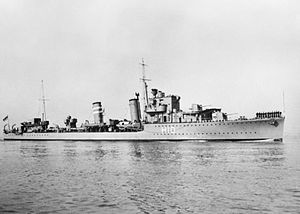 Encounter moving slowly, July 1938
| |
| Class overview | |
|---|---|
| Operators | |
| Preceded by | C and D class |
| Succeeded by | G and H class |
| Subclasses | E, F |
| Built | 1933–1935 |
| In commission | 1934–1968 |
| Completed | 18 |
| Lost | 10 |
| Scrapped | 8 |
| General characteristics | |
| Type | Destroyer |
| Displacement | |
| Length | 329 ft (100.3 m) (o/a) |
| Beam | 33 ft 3 in (10.13 m) |
| Draught | 12 ft 6 in (3.81 m) (deep) |
| Installed power |
|
| Propulsion | 2 × shafts; 2 × geared steam turbines |
| Speed | 35.5 knots (65.7 km/h; 40.9 mph) |
| Range | 6,350 nmi (11,760 km; 7,310 mi) at 15 knots (28 km/h; 17 mph) |
| Complement | 145 |
| Sensors and processing systems | ASDIC |
| Armament |
|
| General characteristics (flotilla leaders, where different) | |
| Displacement |
|
| Length | 343 ft (104.5 m) (o/a) |
| Beam | 33 ft 9 in (10.29 m) |
| Installed power | 38,000 shp (28,000 kW) |
| Speed | 36 kn (67 km/h; 41 mph) |
| Complement | 175 |
| Armament | 5 × single 4.7 in guns |
The E and F-class destroyers were a group of 18 destroyers built for the Royal Navy during the 1930s. The ships were initially assigned to the Home Fleet, although they reinforced the Mediterranean Fleet during the Italian invasion of Abyssinia of 1935–36 and enforced the Non-Intervention Agreement during the Spanish Civil War of 1936–1939. After the beginning of the Second World War in August 1939, the E-class ships were mostly assigned to escort duties under the Western Approaches Command, while the Fs were assigned to escort the ships of the Home Fleet. Between them they sank four German submarines through March 1940 while losing only one ship to a submarine.
Most of the sisters were committed to the Norwegian Campaign in April–June where they helped to sink one German destroyer and a submarine. The two E-class minelayer-destroyers helped to evacuate Allied troops from Dunkirk in May–June. Most of the Fs were sent to Gibraltar around the end of June and formed part of Force H where they participated in the attack on Mers-el-Kébir. Two months later they participated in the Battle of Dakar where they sank three Vichy French submarines. During the rest of 1940, they sank one Italian submarine while losing two ships to mines and torpedoes. Force H covered a number of convoys to Malta in 1941, during which they sank one German submarine and lost one destroyer to bombs. Three E-class ships began escorting convoys to Russia in late 1941 and three others were transferred to the Eastern Fleet.
Two of these latter were sunk by Japanese forces in early 1942 and two Fs were transferred to replace them. Many of the Fs reinforced the Arctic convoy escorts during which they fought several engagements with German destroyers and sank one German submarine. Several were detached to escort Malta convoys, during which one ship was lost. Several ships were converted to escort destroyers in late 1942–early 1943 for duty in the North Atlantic and many others were assigned there for extended periods of time where they sank two German submarines. Three of these ships were later transferred to the Royal Canadian Navy. Four of the Es and Fs were sent to the Mediterranean Fleet in mid-1943 to support the invasion of Sicily and remained there into 1944. One of these was transferred to the Royal Hellenic Navy that same year and remained in Greek service until 1956. The ships that remained in the Atlantic sank two German submarines in 1944 before they were recalled to the UK in May to prepare for the invasion of Normandy. There they sank two submarines, although another F-class ship was lost to a mine. The ships mostly returned to the North Atlantic after Overlord or began long refits in Canada.
The three Canadian ships were used to transport troops back to Canada after the end of the war before being broken up in 1947. Most of the British ships were broken up around the same time, although one ship was sold to the Dominican Navy in 1949 and served until 1968.